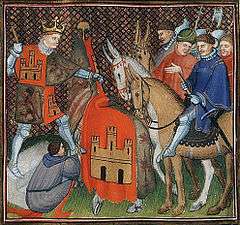Alfonso XI of Castile
| Alfonso XI | |
|---|---|
 Depiction in an illumination of Froissart's chronicles, c. 1410. | |
| King of Castile and Leon | |
| Reign | 7 September 1313 – 26 March 1350 |
| Predecessor | Ferdinand IV |
| Successor | Peter |
| Born |
13 August 1311 Salamanca |
| Died |
26 March 1350[1] (aged 38) Gibraltar, Emirate of Granada |
| Burial | Royal Collegiate Church of Saint Hippolytus |
| Spouse |
Constance of Peñafiel (m. 1325, annulled 1327) Maria of Portugal (m. 1328) |
| Issue among others... |
Peter of Castile (illeg.) Henry II of Castile (illeg.) Fadrique Alfonso (illeg.) Tello Alfonso (illeg.) Sancho Alfonso |
| House | Castilian House of Ivrea |
| Father | Ferdinand IV of Castile |
| Mother | Constance of Portugal |
| Religion | Roman Catholicism |
| Signature |
|
Alfonso XI of Castile (13 August 1311 – 26 March 1350), called the Avenger (el Justiciero), was the king of Castile, León and Galicia. He was the son of Ferdinand IV of Castile and his wife Constance of Portugal. Upon his father's death in 1312, several disputes ensued over who would hold regency, which were resolved in 1313.
Once Alfonso was declared adult in 1325, he began a reign that would serve to strengthen royal power. His achievements include solving the problems of the Gibraltar Strait and the conquest of Algeciras.
Life

Alfonso XI was the son of King Ferdinand IV of Castile and Constance of Portugal. His father died when Alfonso was one year old. His grandmother, María de Molina, his mother Constance, his granduncle Infante John of Castile, Lord of Valencia de Campos, son of King Alfonso X of Castile and uncle Infante Peter of Castile, Lord of Cameros, son of King Sancho IV assumed the regency. Queen Constance died first on 18 November 1313, followed by Infantes John and Peter during a military campaign against Granada in 1319, which left Dowager Queen María as the only regent until her death on 1 July 1321.
After the death of the infantes John and Peter in 1319, Philip (son of Sancho IV and María de Molina, thus brother of Infante Peter), Juan Manuel (the king's second-degree uncle by virtue of being Ferdinand III's grandson) and Juan el Tuerto (his second degree uncle, son of John of Castile who died in 1319) split the kingdom among themselves according to their aspirations for regency, even as it was being looted by moors and the rebellious nobility.
As soon as he took the throne, he began working hard to strengthen royal power by dividing his enemies. His early display of rulership skills included the unhesitant execution of possible opponents, including his uncle Juan el Tuerto in 1326.[2]
He managed to extend the limits of his kingdom to the Strait of Gibraltar after the important victory at the Battle of Río Salado against the Marinid Dynasty in 1340 and the conquest of the Kingdom of Algeciras in 1344. Once that conflict was resolved, he redirected all his Reconquista efforts to fighting the Moorish king of Granada.
He is variously known among Castilian kings as the Avenger or the Implacable, and as "He of Río Salado." The first two names he earned by the ferocity with which he repressed the disorders caused by the nobles during his long minority; the third by his victory in the Battle of Río Salado over the last formidable Marinid invasion of the Iberian Peninsula in 1340.
Alfonso XI never went to the insane lengths of his son Peter of Castile, but he could be bloody in his methods. He killed for reasons of state without any form of trial. He openly neglected his wife, Maria of Portugal, and indulged a scandalous passion for Eleanor of Guzman, who bore him ten children. This set Peter an example which he failed to better. It may be that his early death, during the Great Plague of 1350, at the Fifth Siege of Gibraltar, only averted a desperate struggle with Peter, though it was a misfortune in that it removed a ruler of eminent capacity, who understood his subjects well enough not to go too far.
Alfonso died in the night of 25–26 March 1350 (some sources put the date wrongfully at 27 March).[1]
Marriage and issue
Alfonso XI first married Constanza Manuel in 1325, but had the union annulled two years later. His second marriage, in 1328, was to Maria of Portugal, daughter of Alfonso IV of Portugal.[3] They had:
- Ferdinand (Valladolid, 1332–1333);
- Peter of Castile (1334–1369), King of Castile.
By his mistress, Eleanor of Guzman, he had ten children:
- Pedro Alfonso (1330–1338), Lord of Aguilar de Campoo
- Sancho Alfonso (1331–1343), 1st Lord of Ledesma
- Henry II of Castile (1333–1379) King of Castile (1369-1379);
- Fadrique Alfonso (1333–1358), Henry's twin brother, he was Master of the Order of Santiago and Lord of Haro;
- Fernando Alfonso (1336–c. 1350), 2nd Lord of Ledesma;
- Tello Alfonso (1337–1370), Lord of Aguilar de Campoo
- Juan Alfonso (1341–1359), Lord of Badajoz and Jerez de la Frontera;
- Juana Alfonso, (born 1342), Lady of Trastámara due to her marriage in 1354 to Fernando Ruiz de Castro. The marriage was annulled and in 1366 she married Felipe de Castro;
- Sancho Alfonso (1343–1375), 1st Count of Alburquerque
- Pedro Alfonso (1345–1359)
After Alfonso's death, his widow Maria had Eleanor arrested and later killed.[4]
Appearance
"...King Alfonso was not very tall but well proportioned, and he was rather strong and had fair skin and hair."[5]
Ancestry
| Ancestors of Alfonso XI of Castile | ||||||||||||||||||||||||||||||||||||||||||||||||||||||||||||||||||||||||||||||||||||||||||||||||||||||||||||||||||||||||||||||||||||||||||||||||||||||||||||||||||||||||||||||||||||||||||||||||||||||||||||||||||||||||||||||||||||||||||||||||||||||||||||||||||||||||||||||||||||||||||||||||||||||||||||||||||||||||||||||||||||||||||||||||||||||||||||||||||||||||||||||||||||||||||||||||||||||||||||||||||||||||||||||||||||||||||||||||||||||||||||||||||||||||||||||||||||||||||||||||||||||||||||||||||||||||||||||||||||||||||||||||||||||||||||||||||||||||||||||||||||||||||||||||||||||||||||||||
|---|---|---|---|---|---|---|---|---|---|---|---|---|---|---|---|---|---|---|---|---|---|---|---|---|---|---|---|---|---|---|---|---|---|---|---|---|---|---|---|---|---|---|---|---|---|---|---|---|---|---|---|---|---|---|---|---|---|---|---|---|---|---|---|---|---|---|---|---|---|---|---|---|---|---|---|---|---|---|---|---|---|---|---|---|---|---|---|---|---|---|---|---|---|---|---|---|---|---|---|---|---|---|---|---|---|---|---|---|---|---|---|---|---|---|---|---|---|---|---|---|---|---|---|---|---|---|---|---|---|---|---|---|---|---|---|---|---|---|---|---|---|---|---|---|---|---|---|---|---|---|---|---|---|---|---|---|---|---|---|---|---|---|---|---|---|---|---|---|---|---|---|---|---|---|---|---|---|---|---|---|---|---|---|---|---|---|---|---|---|---|---|---|---|---|---|---|---|---|---|---|---|---|---|---|---|---|---|---|---|---|---|---|---|---|---|---|---|---|---|---|---|---|---|---|---|---|---|---|---|---|---|---|---|---|---|---|---|---|---|---|---|---|---|---|---|---|---|---|---|---|---|---|---|---|---|---|---|---|---|---|---|---|---|---|---|---|---|---|---|---|---|---|---|---|---|---|---|---|---|---|---|---|---|---|---|---|---|---|---|---|---|---|---|---|---|---|---|---|---|---|---|---|---|---|---|---|---|---|---|---|---|---|---|---|---|---|---|---|---|---|---|---|---|---|---|---|---|---|---|---|---|---|---|---|---|---|---|---|---|---|---|---|---|---|---|---|---|---|---|---|---|---|---|---|---|---|---|---|---|---|---|---|---|---|---|---|---|---|---|---|---|---|---|---|---|---|---|---|---|---|---|---|---|---|---|---|---|---|---|---|---|---|---|---|---|---|---|---|---|---|---|---|---|---|---|---|---|---|---|---|---|---|---|---|---|---|---|---|---|---|---|---|---|---|---|---|---|---|---|---|---|---|---|---|---|---|---|---|---|---|---|---|---|---|---|---|---|---|---|---|---|---|---|---|---|---|---|---|---|---|---|---|---|---|---|---|---|---|---|---|---|---|---|---|---|---|---|---|---|---|---|---|---|---|---|---|---|---|---|---|---|---|---|---|---|---|---|---|---|---|---|---|---|---|---|---|---|---|---|---|---|---|---|---|---|---|---|---|---|---|---|---|---|---|---|---|---|---|---|---|---|---|---|---|---|---|---|---|---|---|---|---|---|---|---|---|---|---|---|---|---|---|---|---|---|---|---|---|---|---|---|---|---|---|---|---|---|---|---|---|---|---|---|---|---|---|---|---|---|---|---|---|---|---|---|---|---|---|---|---|---|---|
| ||||||||||||||||||||||||||||||||||||||||||||||||||||||||||||||||||||||||||||||||||||||||||||||||||||||||||||||||||||||||||||||||||||||||||||||||||||||||||||||||||||||||||||||||||||||||||||||||||||||||||||||||||||||||||||||||||||||||||||||||||||||||||||||||||||||||||||||||||||||||||||||||||||||||||||||||||||||||||||||||||||||||||||||||||||||||||||||||||||||||||||||||||||||||||||||||||||||||||||||||||||||||||||||||||||||||||||||||||||||||||||||||||||||||||||||||||||||||||||||||||||||||||||||||||||||||||||||||||||||||||||||||||||||||||||||||||||||||||||||||||||||||||||||||||||||||||||||||
Notes
- 1 2 León-Sotelo & González Crespo 1986, p. 588.
- ↑ Ruiz, Teofilo F., "Towards a Symbolic History of Alfonso XI of Castile: Power, Ceremony and Triumph", The Emergence of León-Castile c.1065–1500: Essays Presented to J.F. O'Callaghan, (James J Todesca, ed.), Ashgate Publishing, Ltd., 2015 ISBN 9781472400444
- ↑ Medieval Iberia: an encyclopedia, 75.
- ↑ Chapman, Charles Edward and Rafael Altamira, A history of Spain, (The MacMillan Company, 1922), 118.
- ↑ From 'Crónica de Pedro' by Pedro López de Ayala (1332–1407)
References
| Wikimedia Commons has media related to Alfonso XI of Castile. |
- Chapman, Charles Edward and Rafael Altamira, A history of Spain, The MacMillan Company, 1922.

- León-Sotelo, María & González Crespo, Esther (1986). "Notas para el itinerario de Alfonso XI en el periodo de 1344 a 1350". En la España Medieval (in Spanish). Vol. 8 no. 5. Complutense University of Madrid. pp. 575–589. ISSN 0214-3038.
- Medieval Iberia: an encyclopedia, Ed. E. Michael Gerli and Samuel G. Armistead, Routledge, 2003.
Alfonso XI of Castile Born: 13 August 1311 Died: 26 March 1350 | ||
| Regnal titles | ||
|---|---|---|
| Preceded by Ferdinand IV |
King of Castile and León 1312–1350 |
Succeeded by Peter |

.svg.png)
